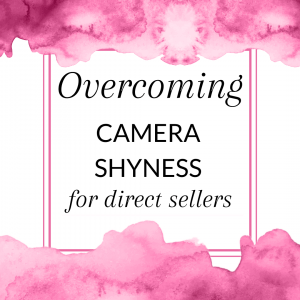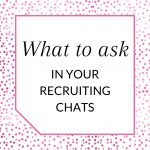
Video is the number one type of content on social media and continues to grow in popularity. Here are some statistics:
- 72% of consumers prefer learning about a product or service through a video
- Viewers retain 95% of a message when they watch it through video
- Social media posts that include a video have 48% more views than those that don’t
- By 2022, online videos will make up more than 82% of all consumer internet traffic (15 times higher than in 2017!)
- 62% of people said they were more interested in a product after seeing it in a Facebook Story
However, so many direct sellers miss out on this tremendous marketing opportunity because they’re uncomfortable in front of the camera. And that’s such a shame! So, if you want to change that and add a video to your social media marketing toolbox, this article is for you.
How to become more comfortable in front of a camera
Practice
Many of us now do regular Zoom or Teams meetings for our jobs. If that’s you, take that opportunity to practice. Turn on your camera in online meetings to get used to it. Ask questions and speak up! You might as well get paid to practice speaking in front of cameras, right?
Self-talk
The next tip is about self-talk. Try to reframe your worries about creating videos into positives. For example, if you’re worried about stumbling over your words, know that this makes you human and relatable to your audience.
If you listen to conversations around you or watch other people’s videos, you’ll notice we all stumble over words or restart sentences all the time. It’s human and normal, so don’t make it into something huge that stops you from creating videos.
Another worry lots of direct sellers have about creating videos is what their friends or family might think of the videos. First, your friends and family are probably not your ideal customers or hosts, so the videos aren’t really for them. Secondly, your friends or family might surprise you with how supportive they can be – give them a chance. But if they truly worry you, start doing videos in places where they don’t hang out: your private Facebook Groups, online parties, TikTok, etc.
A great way to change your self-talk is to embrace the word ‘yet‘. If you find yourself thinking, “I’m so uncomfortable in front of a camera,” or “I don’t know what to talk about,” or “I waffle and get off-track,” or “I don’t like the way I sound,”, use the word ‘yet’ to change it up:
| I’m scared in front of a camera | I’m not comfortable yet in front of a camera |
| I don’t know what to talk about | I don’t know what to talk about yet |
| I waffle too much | I don’t have a structure yet |
| I don’t like the way I sound | I don’t like the way I sound yet |
This is a little psychological trick to get your brain to accept that this is not a fixed thing that’s set in stone but that it’s changing and changing for the better. It’s telling your brain that there is a future in which you are comfortable in front of a camera, in which you don’t waffle, in which you do know what to talk about and in which you do like the way you sound! I know that using the word ‘yet’ seems like such a little thing, but there’s great power in adopting this practice!
The other psychological trick is to adopt a compassionate phrase every time you beat yourself up over a perceived mistake. Let’s say I stumbled over my words in Facebook Live, and I felt awkward. Afterward, I might be hard on myself – which isn’t helpful and only makes me feel bad. The way to combat this habit is to say to yourself, “Even though I stumbled over my words, I still love and accept myself“. It’ll feel a little strange at first, but just trust me and keep saying it until you feel better about the ‘mistake’.
I know it sounds a little woo-woo, but monitoring your self-talk and being kinder to yourself makes a measurable difference. Besides, if you’ve been hard on yourself for years and you are still afraid to get in front of a camera, being mean to yourself doesn’t seem to work too well. Isn’t it time to try something new?
Use an outline
I don’t recommend using a script, it’ll make you sound lifeless, and if you go off-script, you’re likely to panic or waffle.
Instead, use a super simple outline with bullet points. Put that on your screen or paper and refer to that when you need to. Here’s how to structure a quick and simple video:
- Hook: a fun fact, bold statement, or question. You only have 3 seconds to draw people in, so start with something that grabs interest.
- Problem: talk about the problem your customers face and your product solves. Such as messy handbags (your product is a handbag organizer) or dry skin (moisturizer), or not enough time (planner).
- Solution & Tips: show the product that solves the problem and give a usage tip or two. For example: use this pocket for your emergency cash, dab the moisturizer doesn’t rub, or the planner has a special page for shopping lists, but you can also use that for your water intake.
- CTA: end your video with a ‘call to action’. The call to action is what you want the viewer to do. Do you want them to engage and comment? Or do you want them to message you to order? Have a clear call to action, so the viewer knows what to do. Many people miss out on this step in their videos, which is a missed opportunity.
Embrace your mistakes
Don’t let perfect be the enemy of good. Your videos are never going to be perfect. And that’s a good thing! You want to be human, you want to be you, and you want to be relatable. Learn to embrace your mistakes and be kind to yourself (“Even though I made this mistake, I still love and accept myself“).
Use the 5-Second Rule.
Motivational speaker Mel Robbins teaches a psychological trick called the 5-Second Rule. When you want to do something, like creating a video, you must start to physically move within 5 seconds. Otherwise, your brain will find reasons to stop you.
So when you’re thinking, “I really should create a video about this new product“, you count down from 5, and when you reach 1, you physically get up and start working on the outline. Doing this will stop you from overthinking and procrastinating and start working instead.
If you’re a procrastinator, this might work for you.
Keep it rolling
Once you’re set-up, you hit that record button and start with your hook. If you need to restart, don’t stop the recording! Just keep it rolling. You can trim your video later, but you don’t want to stop your action now that you’ve started.
Keep your good bloopers, don’t throw them away. After a while, you’ll see that they’re funny, and you can release your blooper reel. I can guarantee you that you’ll see engagement on that blooper video soar because people can relate to that so much!
Find your format
Live videos are generally the ‘gold standard’ in terms of the algorithm and engagement from the audience. Doing a Live shows your fans that you give them your time right then and there. It’s a great thing to add to your marketing mix. However, you don’t have to do it that way if it doesn’t work for you!
I recommend you try doing a pre-recorded video, Lives, and any other format on social media. But, if after a while you realize that you don’t like Lives, don’t do them. Find the format you like and stick with that. There are many options for adding videos to your social: IGTV, Instagram Reels, Tiktok, YouTube, YouTube Shorts, Facebook Stories, etc.
Start by not showing your face.
One option to make things a little easier if you’re shy is to start your video journey without showing your face. Instead, show a product and do a voice-over. Or perhaps put a product on a whiteboard (put the whiteboard on the table or floor) and draw and write about the product around it, a bit like a mindmap.
Another option is to record yourself flicking through a section of the catalog, perhaps with a voice-over commentary.
You can probably think of more short little videos you can do to add video content without showing your face!
No voice, no problem!
If you don’t like speaking on camera for whatever reason, you can make videos without ever speaking. In fact, you can just make that your thing!
The whiteboard idea from the previous section will work beautifully. Flicking through the catalog will also work fine. You could add text and arrows afterward. You can also use cards or sticky notes to add ‘captions’ to your videos.
Put some music (not copyrighted!) behind the video, and you’ll have a great bit of video content without ever speaking on camera.
I hope these tips will help you get started on social media videos because it’s a tremendous opportunity for direct sellers and party plan consultants, and I don’t want you to miss out on it!

Takeaways
- Use your work’s online meetings to practice being on camera
- Be kind to yourself, and stop tearing yourself down
- Use an outline, not a script
- Embrace your mistakes. You’re human
- Get yourself started with the ‘5-second rule.’
- Keep it rolling once you start filming
- Find your format, and don’t worry about what others say you ‘should’ do
- Create videos without featuring your face or your voice if that’s what’s stopping you
Want to train your brain for success?
Learn the techniques that will have you addicted to setting and achieving your goals!










